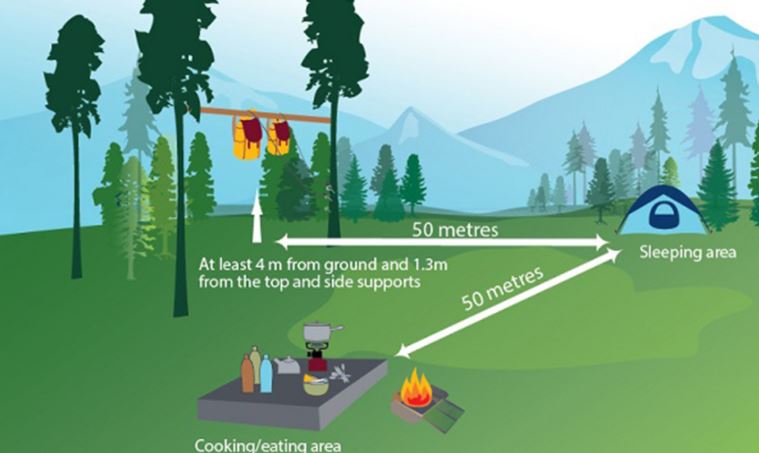
Bear Safety
Wood Buffalo National Park
Safe travel in black bear country
Wood Buffalo National Park hosts a very healthy black bear population. You can run into a bear anywhere here, be it on busy trails and picnic areas, at the campground, along the road or in the remote backcountry. Bear sightings should be anticipated. Though bears generally prefer to avoid people, encounters between bears and people do occur.
Knowing how to avoid an encounter with a bear is the best way to enjoy the park safely. In the event you do come across a bear, it is important to know a bit about bear behaviour. How we respond in an encounter with a bear really depends on the type of interaction that is taking place.
Avoid an encounter | Bear spray | If you see a bear | If the bear approaches | Handling an attack | Cyclists and trail runners | Backcountry camping
If you see a bear by the side of the road
What happens to a bear when it encounters people? | How you can help protect bears
Call the WBNP duty officer to report all black bear sightings at 867-872-0404 or Parks Canada 24 hour emergency dispatch, 1-780-852-3100.
Call these numbers if you see:
- Injured or dead wildlife
- A bear in the campground or picnic areas
- You see Unsafe or aggressive human-wildlife interactions
AVOID an encounter: the best approach
Bears are extremely sensitive to the stress of human activity. You can help protect these animals by avoiding encounters with them.
- Make noise! Let bears know you're there. Call out, clap, sing or talk loudly especially near streams, dense vegetation and berry patches, on windy days, and in areas of low visibility. Bear bells are not enough.
- Watch for fresh bear signs. Tracks, droppings, diggings, torn-up logs and turned-over rocks are all signs that a bear has been in the area. Leave the area if the signs are fresh.
- Keep your dog on a leash at all times or leave it at home. Dogs can provoke defensive behaviour in bears.
- Larger size groups are less likely to have a serious bear encounter. We recommend hiking in a tight group of four or more. Never let children wander.
- Use officially marked paths and trails (where relevant) and travel during daylight hours.
- If you come across a large dead animal, leave the area immediately and report it to park staff.
Bear Spray
Carry bear spray with you at all times on the trail, and know how to use it.
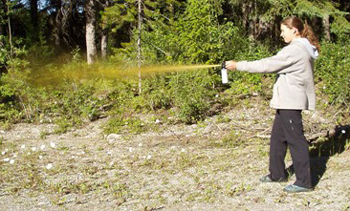
Bear spray can be effective with some bears when used properly. Be aware that wind, spray distance, rain, freezing temperatures and product shelf life can all influence its effectiveness. Familiarize yourself with the proper use of bear spray (including the manufacturer’s specific instructions) and keep it readily accessible.
What is bear spray and how do I use it?
If you SEE a bear
Stop and remain calm. Get ready to use your bear spray. Do not run away.
Is the bear UNAWARE of your presence?
Move away quietly without getting its attention.
Is the bear AWARE of your presence?
Bears may bluff their way out of an encounter by charging and then turning away at the last second. Bears may also react defensively by woofing, growling, snapping their jaws and laying their ears back.
- Stay calm. Your calm behaviour can reassure the bear. Screams or sudden movements may trigger an attack.
- Speak to the bear. Talk calmly and firmly. This lets the bear know you are human and not a prey animal. If a bear rears on its hind legs and waves its nose about, it is trying to identify you.
- Back away slowly. Never run! Running may trigger a pursuit.
- Make yourself appear BIG. Pick up small children and stay in a group.
- Do not drop your pack. It can provide protection.
- If you must proceed, make a wide detour around a bear or wait at a safe distance for it to move on.
If the bear APPROACHES
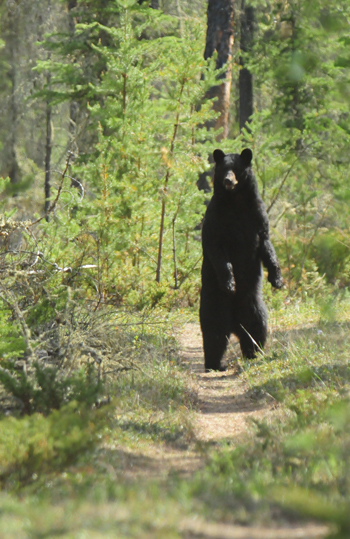
- Stop and remain calm.
- Get ready to use your bear spray.
- Do not run away.
Assess the bear’s behaviour and determine why it is approaching.
Is it DEFENSIVE?
The bear is feeding, protecting its young and/or surprised by your presence. It sees you as a threat. The bear will appear stressed or agitated and may vocalize.
- Try to appear non-threatening.
- Talk in a calm voice.
- When the bear stops advancing, start slowly moving away.
- If it keeps coming closer, stand your ground, keep talking, and use your bear spray.
- If the bear makes contact, fall on the ground and play dead. Lie still and wait for the bear to leave.
Is it NON-DEFENSIVE?
A bear may be curious, after your food, or testing its dominance. In the rarest case, it might be predatory–seeing you as potential prey. All of these non-defensive behaviours can appear similar and should not be confused with defensive behaviours.
The bear will be intent on you with head and ears up.
- Talk in a firm voice.
- Move out of the bear’s path.
- If it follows you, stop and stand your ground.
- Shout and act aggressively.
- Try to intimidate the bear.
- If it approaches closely, use your bear spray.
Handling an ATTACK
Most encounters with bears end without injury. A bear ATTACK is when a bear actually makes contact with you. If this does occur,you may increase your chances of survival by following these guidelines. In general, there are 2 kinds of attack:
Defensive
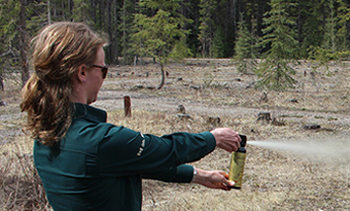
This is the most COMMON type of attack.
- Use your bear spray.
PLAY DEAD! Lie on your stomach with legs apart and position your arms so that your hands are crossed behind your neck. This position makes you less vulnerable to being flipped over and protects your face, the back of your head and neck. Remain still until you are sure the bear has left the area.
These defensive attacks are generally less than two minutes in duration. If the attack continues, it may mean it has shifted from defensive to predatory—FIGHT BACK!
Predatory
The bear is stalking (hunting) you along a trail and then attacks. Or, the bear attacks you at night. This type of attack is very RARE.
Try to escape into a building, car or up a tree.
- If you cannot escape, do not play dead.
- Use your bear spray and FIGHT BACK.
FIGHT BACK! Intimidate that bear: shout; hit it with a branch or rock, do whatever it takes to let the bear know you are not easy prey. This kind of attack is very rare, but it is serious because it usually means the bear is looking for food and preying on you.
It is very difficult to predict the best strategy to use in the event of a bear attack. That is why it is so important to put thought and energy into avoiding an encounter in the first place.
Mountain Bikers and Trail Runners
Your speed and quietness put you at risk for sudden bear encounters.
- Slow down through shrubby areas and when approaching blind corners.
- Make noise, travel in groups, be alert and always watch ahead.
- Carry bear spray with you at all times on the trail, and know how to use it.
Frontcountry Camping
For information and bear safety considerations when using Pine Lake Campground or Kettle Point Group Campground, please visit their website. Be sure to learn and follow the principles of the Bare Campsite program when frontcountry camping in any national park campground.
Backcountry Camping
Wilderness travel requires self-sufficiency and extra awareness to reduce the likelihood of negative bear encounters. Visit the backcountry travel safety page for more information on how to stay safe while backcountry camping in Wood Buffalo National Park.
If you see a bear by the road
Slow down—consider not stopping. Stay in your vehicle! Bears need to forage undisturbed in order to gain enough fat to survive the winter. Your decision to drive on by gives bears the space they need to make a living in this challenging landscape.
At all times...
- Observe and photograph bears from the safety of your car.
- Remain a respectful distance from the bear.
- Never feed a bear.
If you stop...
- Stay in your vehicle! Never get out to approach wildlife.
- Be aware of the traffic around you.
- Pull over where it is safe to do so. Shoulders on park highways are limited.
- Use your hazard lights to alert other drivers.
- Watch for a few moments, take a quick photo, and then move on!
What happens to a bear when it encounters people?
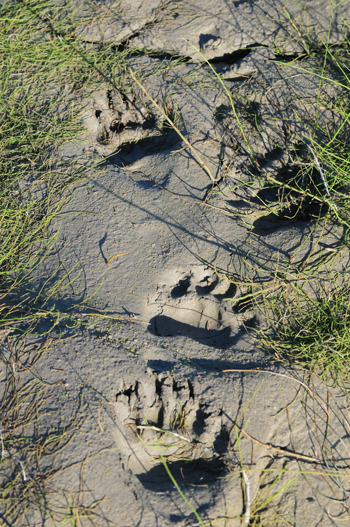
- It can alter its path of travel or abandon an area, displacing it from important habitat.
- It can react aggressively: this usually only happens when the bear is surprised at close range and feels threatened. Serious human-bear encounters may result in the bear's destruction and loss from the ecosystem. 3. It becomes habituated: with frequent, repeated exposure to people, a bear loses its natural wary behaviour and becomes increasingly bolder. It is more likely to enter a campground or townsite where food or garbage may be improperly stored.
More Tips for Roadside Bear Viewing
How you can help protect bears
The best thing you can do for bears is to limit their exposure to you.
- Consider not stopping when you see a roadside bear.
- Put all garbage in bear-proof garbage bins.
- Keep your picnic or camping site attractant-free. Move the food, cooler, dirty dishes, recyclables, BBQ, lotions and pet food into your vehicle, trailer or storage locker (tents are not bear-proof).
- When in the front country, use official trails only and leave the wild trails to wildlife.
- Respect closures and group access requirements—they are in place for your safety and to give bears a chance to use critical habitat undisturbed.
- Pay attention to warnings—follow recommendations. Be careful when travelling through these areas, or choose a different route.
Conservation is not just about bears; it is about protecting the whole ecosystem. Parks Canada has a responsibility to protect wildlife and their habitats. This is a shared responsibility between visitors and Parks Canada alike. As a national park visitor, you can help protect bears and reduce the likelihood of an unpleasant bear encounter by learning more about bear behaviour.
For more information talk to Parks Canada Visitor Centre staff or explore some of these additional bear safety links.
- Bear Safety in the NWT: https://www.enr.gov.nt.ca/en/services/bear-safety
- Alberta Bear Smart: https://www.alberta.ca/alberta-bearsmart.aspx
- Date modified :
